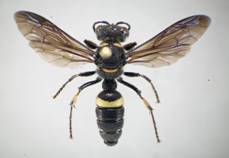DACF Home → Bureaus & Programs → Maine Forest Service → Forest Health & Monitoring → Invasive Threats to Maine's Forests and Tree → Biosurvellance: Using a native wasp to monitor for Emerald Ash Borer → Information for Volunteers → How to find the wasp that hunts emerald ash borer
Wasp Watcher Cerceris fumipennis
How to find the wasp that hunts emerald ash borer
This native wasp is not known to sting humans, even when handled.
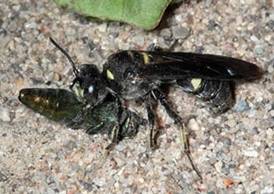
Female Cerceris with Emerald Ash Borer
This native wasp is not known to sting humans, even when handled.

Female Cerceris with Emerald Ash Borer
Cerceris fumipennis is a solitary ground-nesting wasp. The female stocks her nest with buprestid beetles, including emerald ash borer (EAB) when present.
Biosurveillance (observing colonies of these native wasps and collecting some of the prey they bring back) is currently the most promising way to monitor for EAB. The Maine Forest Service is looking for colonies of these wasps throughout the state, and would like your help.
- ½ - ¾ inch long
- dark smoky brown wings
- one cream/yellow band on second segment of abdomen (near “waist”)
- three large cream’/yellow spots on face
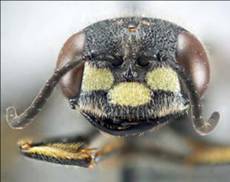
Markings of Female Cerceris fumipennis
(photos by P. Careless)
In New England Cerceris can be found only in July and August
(Cerceris is pronounced: 'ser-ser-iss)
What are Promising Nest Sites?
- hard packed sandy soil
- areas of human disturbance where the disturbance has been present for more than three years.
(school playing fields, baseball diamonds, trail and road edges, informal parking lots, fire-pits, camp-sites, etc.)
- full sunshine
- sparse vegetation (about 50% hard-packed soil and 50% short vegetation)
- near a wooded area (about 200 yards or less)
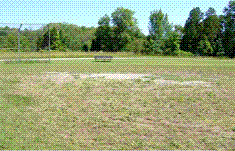
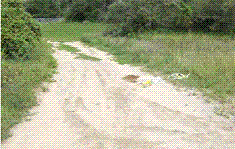
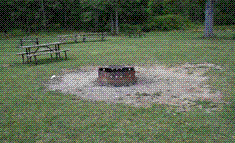
Typical Cerceris Colony Sites
(photos by P. Careless)
- round holes the diameter of a pencil
- holes go straight down (not angled into the ground)
- surrounded by a circle of excavated soil (not all to one side like a dog would dig)
- often tucked beside or under a clump of grass
- from 3-300 nests in a colony
Tip: Until you become familiar with Cerceris nests, carry a small piece of plastic or cardboard with a standard "hole punch" hole in it. This is about the size of a nest opening.
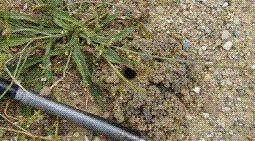
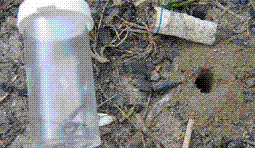
Cerceris Nests
(photos by P. Careless)
(Remember, if you want to monitor these colonies for EAB, they should be within 400 yards of ash trees.)
- Carry out biosurveillance at your site 3-4 warm sunny afternoons during July.
- Choose 30-100 nests in one area (as many as you can keep an eye on).
- At each nest, pin the ‘collar’ to the ground with golf tee, placing the second hole over the nest entrance.
- Wasps without prey can come and go easily through the hole (A). A wasp carrying prey will not fit through the hole (B).
- For 1-3 hours, watch as wasps return to nests. Wasps with prey can be netted in flight or caught as they try to pass through the collar. Take prey and release wasp.
- Collect a total of 50 beetles over 3-4 visits. Place beetles from each day in a baggie labeled with place and date. Place in freezer and mail to us at end of summer.
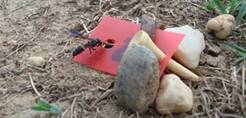
A - Wasp Entering Nest Through Collar
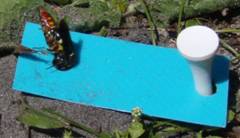
B - Wasp Unable to Enter With Prey
??????? (photos by P. Careless & M. Bohne
- Small metallic green beetle (1/2” long, 1/8” wide)
- An exotic beetle from Asia
- Larva tunnels under the bark
- Attacks and kills all species of ash
- First found in Michigan in 2002
- Spreading VERY rapidly across the USA and Canada (primarily in firewood)
- Early detection is difficult. This wasp and WaspWatchers can help.
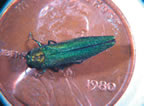
Emerald Ash Borer
If you think you have found a Cerceris colony or would like more information, please contact:
Colleen Teerling: colleen.teerling@maine.gov
phone: (207) 287-3096
How to Carry out Biosurveillance: Looking for Emerald Ash Borer with the Cerceris Wasp
The Maine Forest Service will provide the following equipment:
1-2 lightweight insect nets / group of wasp watchers
golf tees and plastic collars to go over wasp nest holes
plastic baggies containing a layer of tissue for the collection and storage of beetles
a postage-paid box for the return of beetles to us at end of the summer
a sample of emerald ash borer (EAB)
data collection sheets
Visit your site a minimum of 3 hot sunny afternoons during the month of July (August if necessary, but July is preferred) for beetle collection. Wasps hunt best on sunny days when the temperature is above 73° F or 23° C. The peak flight time is 11 am to 4 pm, so visit your site during this time.
At your site, walk around and roughly count the number of nests. Record this on your data sheet. This information will let us know how the wasps are doing over time.
Pick up all dropped beetles lying on the ground around the colony. Some of these may be dry and brittle, so handle carefully. Place these in a baggie and fill out the label, being sure to mark them ‘dropped’.
Choose a group of nests in an area small enough for you (or your group) to watch. This may be between 25 and 80 nests, depending on the size of your group and how often you have done this. If you monitor fewer than 25 nests, the beetle collection will go slowly.
Place collars on the chosen nests. First, hold the collar at right angles to the ground with the flat edge across the centre of the hole. Sweep half of the loose mound of soil surrounding the nest to one side, and the other half to the other side. This will allow you to place the collar on bare ground rather than trying to balance it on top of a mound of excavated soil. Place one hole of the collar over the nest, and use the other hole to anchor it to the ground with a golf tee. If the ground is too hard to push in a golf tee, anchor the collar in place with a small stone.
Watch for wasps coming in with prey. You will soon be able to recognize the slow, heavy flight of a wasp with prey and the bottom-heavy silhouette. You have two options for collecting prey:
1) Gently net the wasp returning with prey. Use a lightweight net (mesh, not canvas), so you do not hurt the wasp. The shock of netting will usually force the wasp to drop her prey. If you see a beetle in the bottom of the net, open the net and let the wasp crawl out and fly away. If she has not released the beetle, through the net, gently pry it away from her with your fingers. Remember, she doesn’t sting.
2) At the nest entrance, you will hear her buzzing as she tries to enter through the hole in the collar with her prey. Using your fingers, gently pry the beetle away from her.
Place these ‘stolen’ beetles in a separate baggie from the dropped ones and fill out the label. Collect up to 20 beetles in each visit to your site.
Fill out data sheet for that day.
Place the two labeled baggies of beetles in the mailing box and store in the freezer until the end of summer. Be SURE both baggies are labeled.
General Information:
We are asking you to collect 50 beetles over 3-4 (or more) visits to your site. If you are unable to collect all 50, mail in what you have by the end of the summer. A few beetles are better than none at all.
The month of July is the best time for biosurveillance, since that is when EAB is most active, but if you are unable to collect all 50 beetles in July, finish up in August.
If you find a small green beetle (looking like the EAB sample we gave) during your biosurveillance, please call or email me right away (contact information below). If EAB is found, it is essential we learn about it as soon as possible.
Thank you for your assistance!
For more information, see
www.cerceris.info or www.maine.gov/cerceris
If you have questions or concerns, please contact me:
Colleen Teerling
Entomologist, Maine Forest Service
ph: (207) 287-3096
email: colleen.teerling@maine.gov
